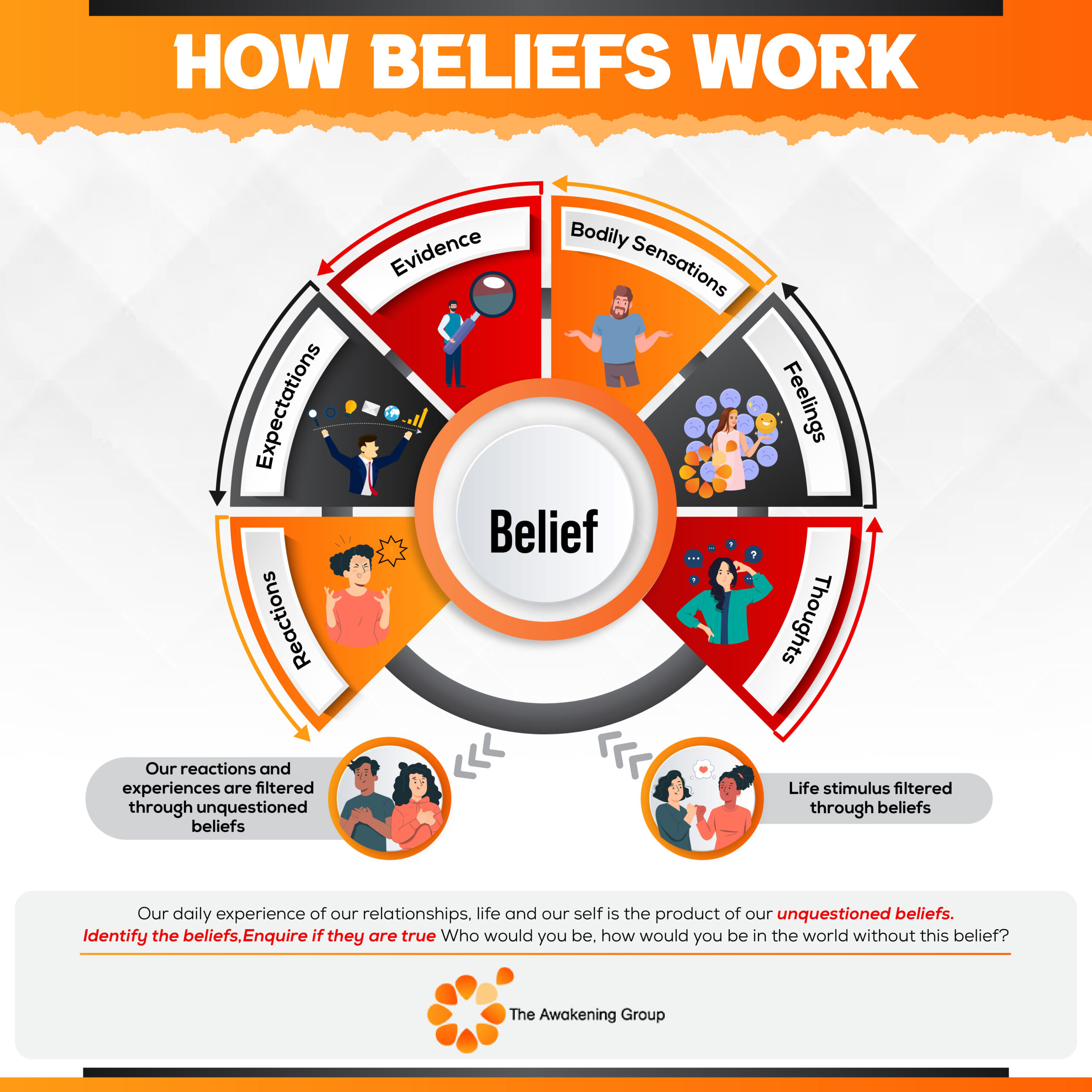Our whole life experience is filtered through beliefs. Our relationships and how we respond to each other is filtered through beliefs. Beliefs change the way we see the world, ourselves, each other, our environment, success, and our day to day experience of life itself. If beliefs are this fundamental in to our human experience it bids the questions: “How does a belief work?”, and “How do we change our beliefs to change our experience?”
How is a Belief Created?
Firstly lets look at how beliefs are created. There are many ways beliefs are formed from the moment we are born through modelling; taking on our parents beliefs either about life, the opposite gender, work, reality and the truth of who you are. Different beliefs are cultivated depending on the culture, country, era and socio-economic we were born into. These values and beliefs are easily heard in ones narrative. For example those from wealth will talk about the people they ‘know’ whereas those from lower socio-economic groups will talk about how they are ‘surviving’, discounts and bargains. Middle class will speak about what they are ‘doing’ in terms of work, projects, holidays, hobbies etc.
Beliefs are also formed through our personal experience of life, each other, our disappointments, opportunities and subsequently decisions we make based on what has happened to us. ie those who have experienced dangerous relationships could form beliefs such as ‘Life is dangerous’, ‘You cannot trust anyone‘, ‘Something bad is going to happen‘ ‘I can only rely on myself‘ ‘There is something wrong with me‘ and many more. Life is then filtered through these unquestioned beliefs and the suffering continues.
Media, peers, beliefs required to adhere to in line with group conscience and what is required to belong. Suggestions made by authority figures, the political narrative at the time, religion influence our beliefs greatly.
Our ancestry affects our beliefs. Much research has been made on how to influence the next population and it has been shown that if you influence the grandmothers they stop war. Furthermore we are also loyal to our family and will take on beliefs, not only to belong but to tell another family members story. Examples of this is: ‘Life is hard’, ‘You have to work hard for everything you get’, how we discipline children, and I am sure you have a few of your own beliefs reverberating from your parents, and grandparents into your own life. The list goes on as how beliefs form yet as we become more self governing we have the resources to enquire into the beliefs that cause suffering, despite how they were formed.
How Does a Belief Work?
As you can see from the diagram above, stimulus from our environment enters the brain and the neurological system and is filtered through our whole nervous system but also associative memory which has unconscious beliefs inherent in it. As it is filtered through the beliefs that we have taken on unwittingly so throughout our life, it creates feelings, reactions in the nervous system either signally to the body it is a threatening situation or all is well thus producing bodily reactions. Furthermore beliefs gather evidence to prove they are correct and filter out anything that does not support them. As our brain automates our environment very quickly to ensure we do not use too many resources in analysing and making decisions continuously, it then assumes the beliefs are true without questioning them, thus becoming transparent and in nestled into the subconscious, until they cause suffering. At this stage beliefs self generate their own internal emotional and sensory world within us, again with particular feelings, thoughts, bodily sensations and reactions in the nervous system, that then solidifies them to be correct. Beliefs are then normalised and we expect life, people, ourself to be our belief that we have taken on unquestioningly. To sustain the belief it continually gathers evidence to prove it is correct. Our reaction to life is then filtered through beliefs that no longer serve us and often cause conflict and suffering and in war, internally and externally!
How To Change Beliefs that Cause Suffering?
No matter how a belief was formed or how a belief works there is a very simple and elegant way of transforming them. Byron Katie in the late 80’s after years of depression and whilst in a Women’s centre, experienced an epiphany that led to her discovering how to lessen the effects of stressful thinking. Today this method is used worldwide and simply involves enquiring into a belief in such a way that the belief lets go of you.
Enquiry Exercise:
- Take a moment to think of stressful situation.
- Ask ‘What would someone believe in order to experience these feelings, stress, sensations?’ Keep the statement simple. Write it down
- Take this belief and bring it to enquiry by asking:
- Is it true? Really have a look in your heart to find whether the belief is really true as we are looking at reality here not what you think is true. See if you can find a Yes or a No, not a sometimes or maybe. Go deeper into really checking reality.
- Can you absolutely know it to be true? In your heart of hearts can you absolutely know this to be true?
- How do react when you believe this thought? What happens to you?
- How do you treat yourself, others, life when you believe this thought?
- Can you find any peaceful reason, in other words it doesn’t cause you stress, for holding onto the belief?
- Can you find a reason to let the belief go? Don’t try to let it go!
- Who or how would you be if this belief never occurred to you? What would you do without this belief?
- Turn the belief around to the opposite, then to ‘Myself and My Thinking’ or if the belief is about another to “Other”; that is how I do to the other what I believe them to be doing to me? Here’s how:
- Belief: ‘I am not good enough’.
- Opposite Turnaround: I am enough
- Myself and My thinking: It is only my thinking that thinks I am not good enough
- Belief: Sam doesn’t appreciate the work that I do
- Opposite: Sam appreciates the work that I do
- Myself and My thinking Turnaround: I don’t appreciate the work that I do
- Other Turnaround: I don’t appreciate the work Sam does
- Belief: ‘I am not good enough’.
- After each turnaround before you find the next one ask:
- Where is that turnaround true in your life?
- See if you can come up with at least 3 incidents where it is true if possible.
- Where is that turnaround true in your life?
We are building new neurological pathways as the belief lets go of you. Whether it is enquiring into the beliefs that cause shame ie ” I am bad’, ‘There is something wrong with me’ or beliefs around money, relationship, another persons’ behaviour, or our own self criticism the result is a whole new reality appears.
When we take a moment to find where the ‘Turnarounds’ are true we get to see that reality is much kinder than our thinking. Not only that, we get to experience a deep sense of peace, joy and love inherent in being human, this is often under unquestioned beliefs that cause suffering. So who would you be without your stressful thinking?
————————–
Workshops
The Work of Byron Katie weekends are held throughout the year for more information and dates go to: https://awakening.com.au/course/the-work-of-byron-katie/
Resources
Byron, Katie Loving What is little booklet
Worksheets – Write it down, ask for questions and turn it around
One Belief at a Time worksheet
Universal Beliefs – Are these some of the beliefs that cause stress in your life?



